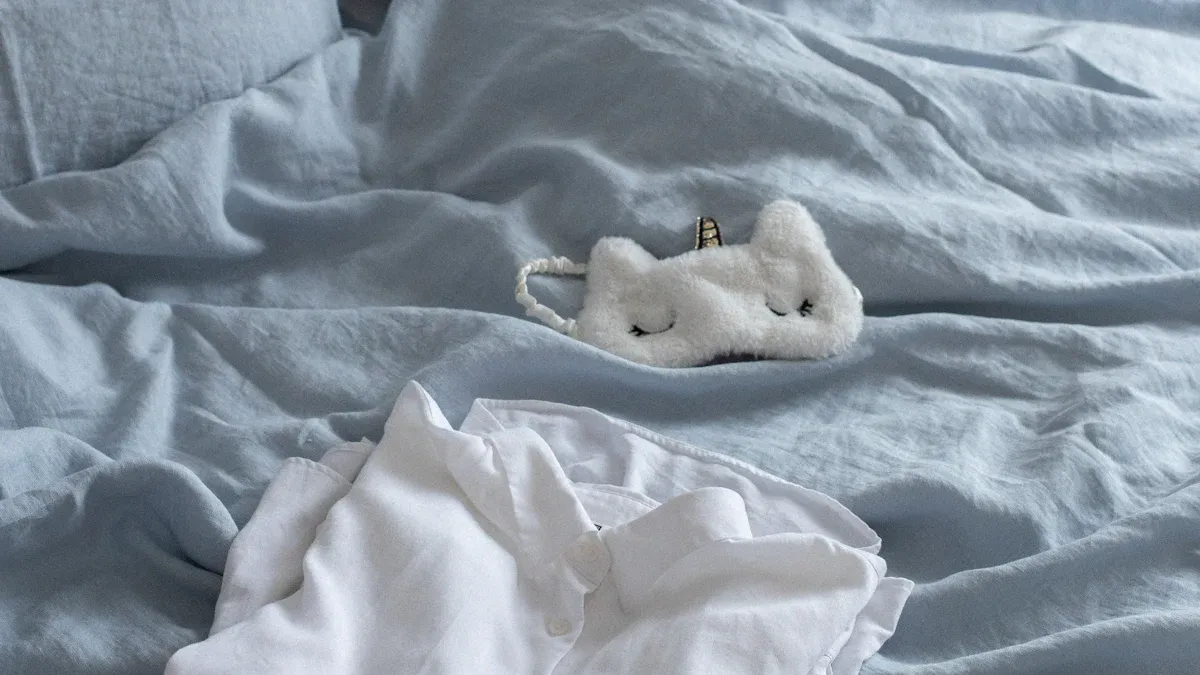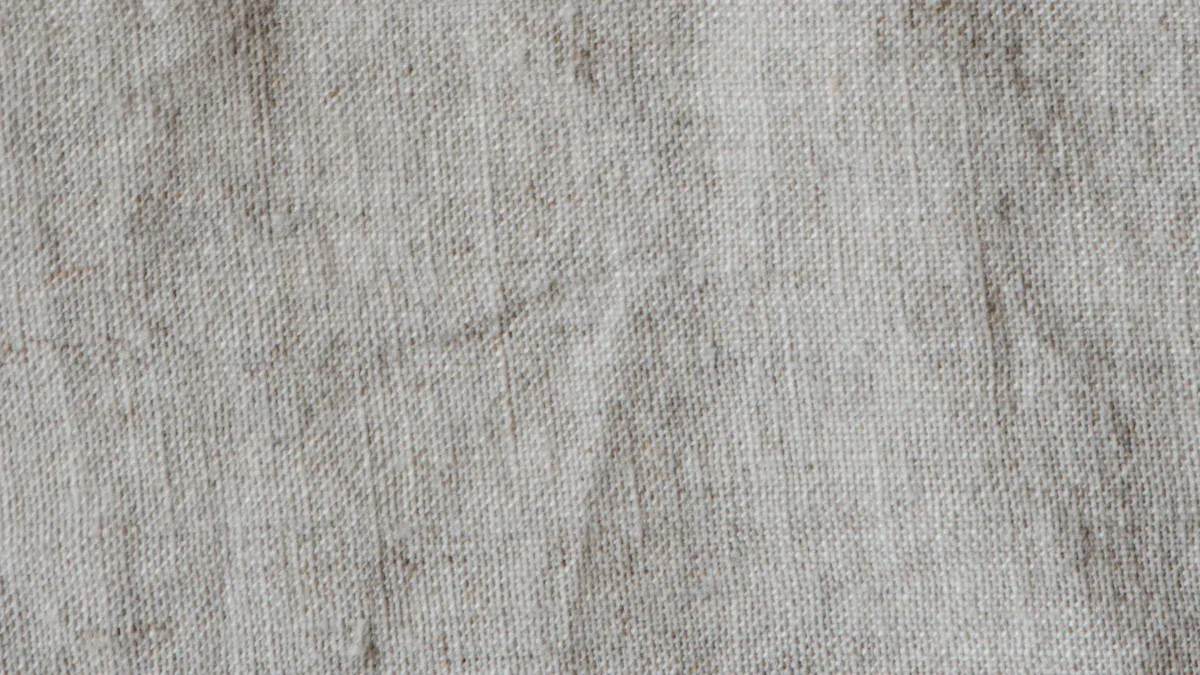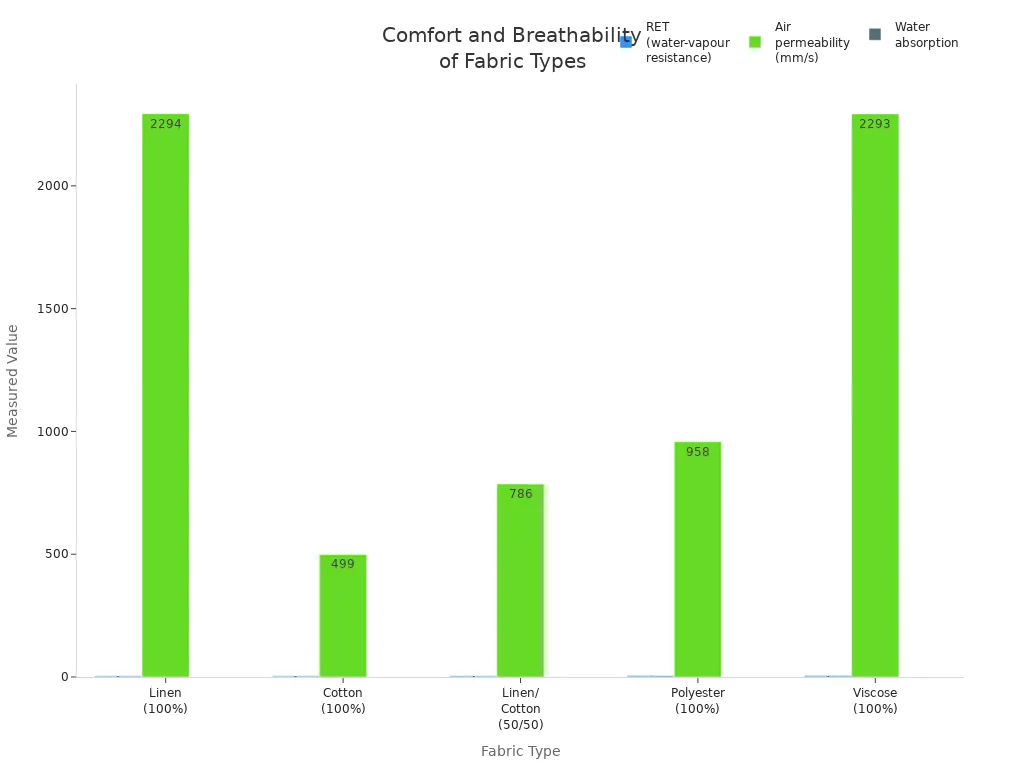
You notice linen fabric texture right away. It feels crisp and cool in your hands. You see tiny slubs, or small bumps, that make every piece unique.
- You enjoy the softness and pliability as you touch it.
- The surface shows a gentle sheen that looks natural, not shiny.
- When you scrunch it, linen does not snap back sharply but stays relaxed.
Linen fabric texture stands out from other fabrics. You experience a fresh, breathable comfort each time you use it.
Key Takeaways
- Linen fabric feels crisp, cool, and textured with natural bumps called slubs that make each piece unique and breathable.
- Linen softens and becomes more comfortable with every wash, making it a smart choice for long-lasting use.
- Compared to cotton, silk, and synthetics, linen offers superior breathability, moisture control, and a natural, relaxed look.
- Real users report better sleep, skin comfort, and lasting durability when using linen bedding and clothing.
- Proper care like gentle washing, air drying, and storing in a cool, dry place keeps linen soft, fresh, and beautiful over time.
Linen Fabric Texture: Tactile and Visual Qualities

How Linen Feels to the Touch
When you touch linen, you notice its crisp and smooth surface right away. Linen feels cool against your skin, making it a favorite for warm weather. Many people describe linen as comfortable and refreshing, especially compared to itchier fabrics like wool. You will find that linen wicks away sweat and keeps you dry. The airflow through the fabric helps you stay cool, even on hot days. Over time, linen fabric texture changes. It starts out crisp and textured, but with each wash, it becomes softer and more inviting. You get a fabric that feels better every time you use it.
Tip: If you want a fabric that gets softer and more comfortable with age, linen is a smart choice.
The Role of Weave and Slubs in Texture
Linen fabric texture stands out because of its natural slubs and unique weave. These slubs are small bumps and uneven sections that you can feel with your fingertips. They come from the natural thickness of the yarn. Here’s how these features make linen special:
- Natural slubs create a textured surface with soft bumps, giving you a one-of-a-kind tactile experience.
- The uneven texture forms tiny air pockets, which boost breathability and keep you cool.
- Linen’s loose weave allows air to flow freely, drawing heat away from your skin.
- The strong flax fibers in linen make it hard to stretch and very durable, so your linen items last for years.
- Different weaves, like plain or damask, change the feel and look of the fabric, from smooth and crisp to airy and lightweight.
You will notice that linen fabric texture feels different from other fabrics. The slubs and weave give it a natural, authentic touch that you can’t find elsewhere.
Visual Appeal and Surface Details
Linen catches your eye with its natural beauty and elegant details. The surface of linen shows off its unique weave patterns, subtle sheen, and gentle wrinkles. These features give linen a relaxed yet refined look. You can see the difference in the table below:
| Visual Characteristic | Description | Example Types and Uses |
|---|---|---|
| Natural Texture | Ranges from smooth and crisp to loosely woven and airy. | Holland linen (smooth, crisp), loosely woven linen (airy) |
| Elegant Appearance | Subtle sheen and reversible patterns add a touch of class. | Damask linen (reversible patterns, intricate designs) |
| Weave Patterns | Plain, twill, and damask weaves create different looks and feels. | Plain-woven linen (versatile), damask linen (decorative) |
| Wrinkling and Luster | Wrinkles easily and has a natural shine, making it stand out. | General linen characteristic |
| Color Palette | Neutral and earthy tones enhance its understated elegance. | General linen characteristic |
| Fabric Variations and Uses | Used for clothing, bedding, curtains, and luxury decor. | Sheeting linen (bed sheets), Venise linen (luxury decor) |
You can also find linen with embroidery or special finishes, which add even more style and function. These details help linen keep its neat, attractive appearance, whether you use it for clothing or home decor. Linen fabric texture gives you a look that is both timeless and modern, making it a favorite for many uses.
Linen Fabric Texture Compared to Other Fabrics
Linen vs. Cotton: Texture and Softness
You might wonder how linen compares to cotton. Both are popular, but they feel very different. Check out this table to see the main differences:
| Feature | Cotton Fabric | Linen Fabric |
|---|---|---|
| Texture | Soft, fluffy with a smooth finish | Coarser, more textured, natural and rustic |
| Feel on Skin | Gentle, ideal for sensitive skin | Initially coarse, softens with use and washing |
| Aesthetic Look | Polished, smooth, versatile | Relaxed, natural, breezy, effortless vibe |
Cotton feels soft right away. You get a gentle touch that works well for sensitive skin. Linen fabric texture starts out coarser, but it changes over time. Each wash makes linen softer and smoother. Cotton may lose its softness after many washes, but linen keeps getting better. If you want bedding or clothing that improves with age, linen is the smart choice.
Tip: Choose linen for long-lasting comfort and a unique, natural feel.
Linen vs. Silk: Smoothness and Elegance
You see a big difference when you compare linen to silk. Silk feels smooth, soft, and slippery. It shines with a rich, glossy look. Linen, on the other hand, feels crisp and textured. It has a natural, lived-in elegance that stands out. Here’s a quick comparison:
| Fabric | Texture Characteristics | Additional Properties |
|---|---|---|
| Linen | Breathable, distinctive texture, slightly coarse, natural textured feel | Looser weave, wrinkles easily, elegant drape |
| Silk | Smooth, soft, fluid, slippery, lustrous sheen | Luxurious drape, lightweight, delicate, requires gentle handling |
Silk gives you a sense of luxury and formality. Linen offers a different kind of beauty. Its texture feels authentic and relaxed. Many people love the way linen drapes and wrinkles, giving your home a sophisticated yet effortless look. Linen’s breathability and natural sheen make it a favorite for bedding and curtains. If you want a fabric that feels real and gets better with time, linen is the answer.
Linen vs. Synthetics: Natural vs. Engineered Feel
You notice a clear difference between linen and synthetic fabrics like polyester. Synthetics feel smooth and resist wrinkles. They dry quickly and last a long time. However, they do not breathe well. You may feel hot and sticky in polyester, especially in warm weather. Linen fabric texture feels cool and crisp. It lets air flow and wicks away moisture, keeping you comfortable even on hot days. Linen’s natural fibers give you a light, airy feel that synthetics cannot match. If you want comfort and breathability, linen stands out as the best choice.
Real User Stories: Living with Linen Fabric Texture

Everyday Comfort and Breathability
You want comfort that lasts all day. Linen gives you that comfort, especially when the weather turns hot and humid. Many users say linen keeps them cool and dry, even when they sweat. The secret lies in the way linen lets air move through the fabric. You feel fresh because linen absorbs moisture and dries quickly. This means you stay comfortable, not sticky or damp.
Take a look at how linen compares to other fabrics:
| Property | Linen (100%) | Cotton (100%) | Linen/Cotton (50/50) | Polyester (100%) | Viscose (100%) |
|---|---|---|---|---|---|
| RET (water-vapour resistance, lower is better) | 3.84 | 3.86 | 4.37 | 4.7 | 4.73 |
| Air permeability (mm/s, higher is better) | 2294 | 499 | 786 | 958 | 2293 |
| Water absorption (higher is better) | 0.388 | 0.386 | 0.316 | 0.314 | 0.340 |

You see that linen stands out for breathability and moisture control. Linen fabric texture allows sweat to pass through and air to circulate. You get a natural cooling effect from the hollow flax fibers. Linen also resists bacteria and allergens, so your skin feels fresh and healthy. Over time, linen softens, making it even more comfortable for daily use.
Note: Linen absorbs up to 20% of its weight in moisture and releases it fast. You stay dry and cool, even on the hottest days.
Suerte Customer Experiences with Linen Bedding
When you choose linen bedding from Suerte, you invest in better sleep and comfort. Customers often mention how linen bedding feels soft and breathable. You notice the crispness at first, but each wash makes your sheets softer. Many people say they sleep better and wake up feeling refreshed.
Here are some highlights from customer feedback:
- You enjoy the gentle touch of linen as it ages.
- Linen bedding absorbs moisture, keeping your skin dry through the night.
- The fabric does not harm your skin. Some even say it helps skin cells grow.
- Linen bedding stays durable and beautiful, even after many washes.
You want bedding that supports your health and comfort. Suerte’s linen bedding delivers both. You get a fabric that feels better every time you use it.
Surprises and Challenges Shared by Users
You may discover unexpected benefits when you use linen. Some users report better sleep, falling asleep faster and waking up in a better mood. Others notice relief from skin problems, like rashes or eczema. Linen’s natural properties—breathability, moisture absorption, and antibacterial effects—help you feel comfortable and healthy.
Here are some surprises and challenges users have shared:
- Some people experience pain relief when using linen wraps or bandages.
- Elderly users notice improved mobility and muscle strength when wearing linen.
- Linen bedding can improve sleep quality and mood.
- Linen rarely causes allergic reactions and can help reduce skin irritation.
- Linen resists static electricity and helps regulate body heat.
You may face a challenge when shopping online for linen. It is hard to judge the softness and weight of linen fabric texture without touching it. This can make you hesitate before buying. To help, many brands now offer fabric swatches, detailed descriptions, and high-quality images. User reviews that focus on fabric feel also help you make a confident choice.
Tip: If you want to experience linen before buying, look for swatch programs or read reviews that describe the fabric’s feel.
You will find that linen adapts to you over time. It starts out crisp but becomes softer and more inviting with every wash. You get a fabric that grows more comfortable the longer you use it.
Practical Tips: Choosing and Caring for Linen Fabric Texture
Selecting the Right Linen Texture for Your Lifestyle
You want linen that fits your daily routine and personal style. Start by thinking about how you plan to use your linen. Consider these factors:
- Blends: Linen mixed with cotton, rayon, or synthetics gives you extra softness, durability, and wrinkle resistance. These blends work well for busy lifestyles or frequent travel.
- Weave Type: Percale feels crisp, sateen feels silky, and twill offers extra strength. Pick the weave that matches your comfort and durability needs.
- Finishes: Look for enzymatic or mercerized finishes if you want added softness and strength.
- Climate: Pure linen keeps you cool in hot, humid weather. Blends may suit cooler climates or year-round use.
- Style: Choose colors and textures that match your home or wardrobe. Linen’s rustic charm stands out, but you can find modern looks too.
Tip: High-quality linen lasts longer and feels better with every wash. Invest in the best you can for your lifestyle.
Washing and Softening Linen Over Time
You can keep your linen soft and strong by following a few simple steps:
- Wash linen in cold or lukewarm water with a mild detergent on a gentle cycle.
- Separate colors and avoid overloading the machine to prevent tangling.
- Air dry by hanging or laying flat. If you use a dryer, remove linen while still slightly damp.
- Iron or steam linen when it is damp to smooth out wrinkles. Remember, natural wrinkles add to linen’s charm.
- Wash linen regularly. Each wash makes it softer and more comfortable.
Repeated washing dissolves natural stiffness and helps linen become even more durable. You get a fabric that improves with age.
Storing and Maintaining Linen’s Unique Feel
Proper storage keeps your linen fresh and beautiful. Follow these tips:
- Store linen in a cool, dry, and dark place to prevent fading and mildew.
- Use breathable cotton bags or acid-free boxes instead of plastic containers.
- Place moisture absorbers like silica gel nearby to control humidity.
- Rotate your linens and change fold lines to avoid permanent creases.
- Hang delicate items on padded or wooden hangers to keep their shape.
- Add natural repellents like cedar or lavender to protect against pests.
Note: Always wash and dry linen before storing it. This step helps prevent stains and odors from setting in.
You deserve comfort that lasts. Linen stands out for its crisp feel, breathability, and natural charm. Real user stories show how you can enjoy softness, durability, and a fabric that grows better with time. Linen resists wear, supports healthy skin, and helps you stay cool or warm as needed. You make a smart, sustainable choice when you choose linen. With care, your linen becomes softer and more inviting, turning every day into a luxury experience.
FAQ
What makes linen fabric texture unique?
You notice linen’s crisp, cool feel right away. Natural slubs and a slightly uneven weave give each piece character. Linen stands out for its breathability and timeless look. You enjoy comfort and style that only improves with time.
How does linen fabric texture change after washing?
You will see linen become softer and more inviting with every wash. The fabric loses its initial stiffness. You get a smoother, cozier feel that makes linen a favorite for bedding and clothing.
Can you use linen fabric for sensitive skin?
You can trust linen for sensitive skin. The natural fibers feel gentle and smooth. Linen resists bacteria and allergens. You enjoy comfort and peace of mind, even if your skin needs extra care.
How do you keep linen looking and feeling its best?
Tip: Wash linen in cool water with mild detergent. Air dry or tumble dry on low. Store in a dry, dark place. Rotate your linens and avoid plastic storage. You keep your linen fresh, soft, and beautiful for years.



